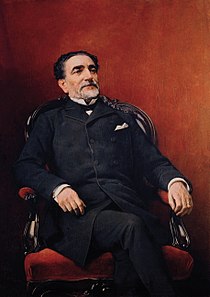Práxedes Mateo Sagasta
show This article may be expanded with text translated from the corresponding article in Spanish. (February 2020) Click [show] for important translation instructions. |
Práxedes Mateo Sagasta | |
|---|---|
 Portrait of Práxedes Mateo Sagasta | |
| Prime Minister of Spain | |
| In office 7 March 1901 – 10 December 1902 | |
| Monarch |
|
| Preceded by | Marcelo Azcárraga |
| Succeeded by | Francisco Silvela |
| In office 5 October 1897 – 7 March 1899 | |
| Monarch | Maria Christina of Austria (regent) |
| Preceded by | Marcelo Azcárraga |
| Succeeded by | Francisco Silvela |
| In office 13 December 1892 – 24 March 1895 | |
| Monarch | Maria Christina of Austria (regent) |
| Preceded by | Antonio Cánovas del Castillo |
| Succeeded by | Antonio Cánovas del Castillo |
| In office 28 November 1885 – 8 July 1890 | |
| Monarch | Maria Christina of Austria (regent) |
| Preceded by | Antonio Cánovas del Castillo |
| Succeeded by | Antonio Cánovas del Castillo |
| In office 10 February 1881 – 14 October 1883 | |
| Monarch | Alfonso XII |
| Preceded by | Antonio Cánovas del Castillo |
| Succeeded by | José Posada Herrera |
| Personal details | |
| Born | 21 July 1825 Torrecilla en Cameros, Logroño, Spain |
| Died | 5 January 1903 (aged 77) Madrid, Spain |
| Resting place | Pantheon of Illustrious Men |
| Nationality | Spanish |
| Political party | Liberal Party |
| Signature | |
Práxedes Mariano Mateo Sagasta y Escolar (21 July 1825 – 5 January 1903) was a Spanish civil engineer and politician who served as Prime Minister on eight occasions between 1870 and 1902—always in charge of the Liberal Party—as part of the turno pacifico, alternating with the Conservative leader Antonio Cánovas. He was known as an excellent orator.
Biography[]
Mateo-Sagasta was born on 21 July 1825 at Torrecilla en Cameros, province of Logroño, Spain. As a member of the Progressive Party while a student at the Civil Engineering School of Madrid in 1848, Sagasta was the only one in the school who refused to sign a letter supporting Queen Isabel II.
After his studies, he took an active role in government. Sagasta served in the Spanish Cortes between 1854–1857 and 1858–1863. In 1866 he went into exile in France after a failed coup. After the Spanish Revolution of 1868, he returned to Spain to take part in the newly-created provisional government.
He served as Prime Minister of Spain during the Spanish–American War of 1898 when Spain lost its remaining colonies. Sagasta agreed to an autonomous constitution for both Cuba and Puerto Rico. Sagasta's political opponents saw his action as a betrayal of Spain and blamed him for the country's defeat in the war and the loss of its island territories in the Treaty of Paris of 1898. He continued to be active in politics for another four years.
Sagasta died on 5 January 1903 in Madrid at the age of 77.[1]
References[]
- ^ "Obituary. Señor Práxedes Mateo Sagasta". Annual Register for 1903. Longmans, Green, and Co. 1904. p. 113.
External links[]
- 1825 births
- 1903 deaths
- Politicians from La Rioja
- Progressive Party (Spain) politicians
- Constitutional Party (Spain) politicians
- Liberal Party (Spain, 1880) politicians
- Prime Ministers of Spain
- Economy and finance ministers of Spain
- Presidents of the Congress of Deputies (Spain)
- Members of the Congress of Deputies (Spain)
- Members of the Congress of Deputies of the Spanish Restoration
- Leaders of political parties in Spain
- Spanish civil engineers
- Spanish people of the Spanish–American War
- Polytechnic University of Madrid alumni
- Knights of the Golden Fleece of Spain
- Knights of the Holy Sepulchre
- Government ministers during the First Spanish Republic